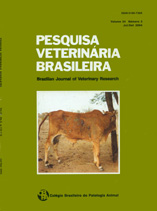 |
|
|
|
Year 2004 - Volume 24, Number 3
|

|
Avaliação da patogenicidade de amostras de Brachyspira pilosicoli através de técnicas histopatológicas convencionais e por imuno-histoquímica
|
Paulovich F.B., Borowski S.M., Driemeier D., Razia L.E., Coutinho T. A., Prates A.B.H., Pescador C., Correa A. & Barcellos D.E.S.N. 2004. [Assessment of the pathogenicity of Brachyspira pilosicoli strains by conventional histopathological techniques and by immunohistochemistry.] Avaliação da patogenicidade de amostras de Brachyspira pilosicoli através de técnicas histopatológicas convencionais e por imuno-histoquímica. Pesquisa Veterinária Brasileira 24(3):144-148. Depto Patologia Clínica Veterinária, Faculdade de Veterinária, UFRGS, Cx. Postal 15094, Porto Alegre, RS 91540-000, Brazil. E-mail: davetpat@vortex.ufrgs.br
The study assessed differences of pathogenicity among 19 strains of Brachyspira pilosicoli isolated from cases of diarrhea in swine in the State of Rio Grande do Sul, Brazil, using an one-day-old chick model. The chicken inoculated with live bacterial cultures were submitted to euthanasia 21 days later, and the cecum was examined histologically using hematoxylin-eosin, silver staining and immunohistochemistry with a polyclonal antibody anti-Brachyspira pilosicoli. With silver staining and immunohistochemistry, respectively, 21.59% and 70.96% of the chicken showed colonization of the cecal epithelium with B. pilosicoli. Differences in the type of colonization characterized by continuous adhesion, focal adhesion or free bacteria in the intestinal lumen were observed. Immunohistochemistry was more efficient to assess intestinal colonization, because 49.37% more colonized chicken could be detected with silver staining. With three strains, elongated figures inside the cytoplasm of epithelial cecal cells in the inoculated chicken were observed. |
| |
|
|
| |
|
 |